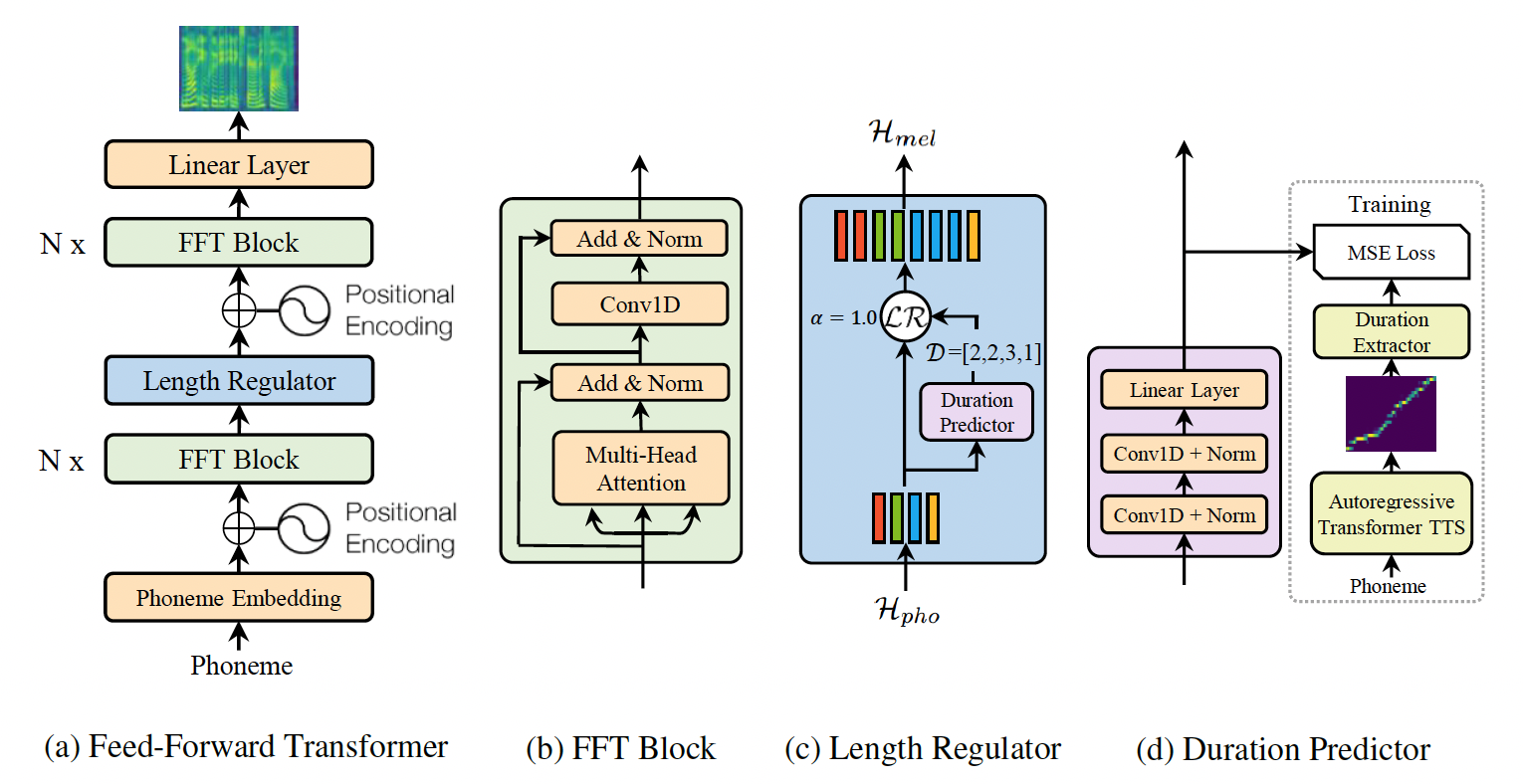|
|
||
|---|---|---|
| .. | ||
| alignments | ||
| configs | ||
| images | ||
| README.md | ||
| data.py | ||
| synthesis.py | ||
| synthesis.sh | ||
| train.py | ||
| train.sh | ||
README.md
Fastspeech
PaddlePaddle dynamic graph implementation of Fastspeech, a feed-forward network based on Transformer. The implementation is based on FastSpeech: Fast, Robust and Controllable Text to Speech.
Dataset
We experiment with the LJSpeech dataset. Download and unzip LJSpeech.
wget https://data.keithito.com/data/speech/LJSpeech-1.1.tar.bz2
tar xjvf LJSpeech-1.1.tar.bz2
Model Architecture
FastSpeech is a feed-forward structure based on Transformer, instead of using the encoder-attention-decoder based architecture. This model extracts attention alignments from an encoder-decoder based teacher model for phoneme duration prediction, which is used by a length regulator to expand the source phoneme sequence to match the length of the target mel-spectrogram sequence for parallel mel-spectrogram generation. We use the TransformerTTS as teacher model. The model consists of encoder, decoder and length regulator three parts.
Project Structure
├── config # yaml configuration files
├── synthesis.py # script to synthesize waveform from text
├── train.py # script for model training
Saving & Loading
train_transformer.py and train_vocoer.py have 3 arguments in common, --checkpoint, --iteration and --output.
-
--outputis the directory for saving results. During training, checkpoints are saved in${output}/checkpointsand tensorboard logs are saved in${output}/log. During synthesis, results are saved in${output}/samplesand tensorboard log is save in${output}/log. -
--checkpointis the path of a checkpoint and--iterationis the target step. They are used to load checkpoints in the following way.-
If
--checkpointis provided, the checkpoint specified by--checkpointis loaded. -
If
--checkpointis not provided, we try to load the checkpoint of the target step specified by--iterationfrom the${output}/checkpoints/directory, e.g. if given--iteration 120000, the checkpoint${output}/checkpoints/step-120000.*will be load. -
If both
--checkpointand--iterationare not provided, we try to load the latest checkpoint from${output}/checkpoints/directory.
-
Compute Phoneme Duration
A ground truth duration of each phoneme (number of frames in the spectrogram that correspond to that phoneme) should be provided when training a FastSpeech model.
We compute the ground truth duration of each phomemes in the following way. We extract the encoder-decoder attention alignment from a trained Transformer TTS model; Each frame is considered corresponding to the phoneme that receive the most attention;
You can run alignments/get_alignments.py to get it.
cd alignments
python get_alignments.py \
--use_gpu=1 \
--output='./alignments' \
--data=${DATAPATH} \
--config=${CONFIG} \
--checkpoint_transformer=${CHECKPOINT} \
where ${DATAPATH} is the path saved LJSpeech data, ${CHECKPOINT} is the pretrain model path of TransformerTTS, ${CONFIG} is the config yaml file of TransformerTTS checkpoint. It is necessary for you to prepare a pre-trained TranformerTTS checkpoint.
For more help on arguments
python alignments.py --help.
Or you can use your own phoneme duration, you just need to process the data into the following format.
{'fname1': alignment1,
'fname2': alignment2,
...}
Train FastSpeech
FastSpeech model can be trained by running train.py.
python train.py \
--use_gpu=1 \
--data=${DATAPATH} \
--alignments_path=${ALIGNMENTS_PATH} \
--output=${OUTPUTPATH} \
--config='configs/ljspeech.yaml' \
Or you can run the script file directly.
sh train.sh
If you want to train on multiple GPUs, start training in the following way.
CUDA_VISIBLE_DEVICES=0,1,2,3
python -m paddle.distributed.launch --selected_gpus=0,1,2,3 --log_dir ./mylog train.py \
--use_gpu=1 \
--data=${DATAPATH} \
--alignments_path=${ALIGNMENTS_PATH} \
--output=${OUTPUTPATH} \
--config='configs/ljspeech.yaml' \
If you wish to resume from an existing model, See Saving-&-Loading for details of checkpoint loading.
For more help on arguments
python train.py --help.
Synthesis
After training the FastSpeech, audio can be synthesized by running synthesis.py.
python synthesis.py \
--use_gpu=1 \
--alpha=1.0 \
--checkpoint=${CHECKPOINTPATH} \
--config='configs/ljspeech.yaml' \
--output=${OUTPUTPATH} \
--vocoder='griffin-lim' \
We currently support two vocoders, Griffin-Lim algorithm and WaveFlow. You can set --vocoder to use one of them. If you want to use WaveFlow as your vocoder, you need to set --config_vocoder and --checkpoint_vocoder which are the path of the config and checkpoint of vocoder. You can download the pre-trained model of WaveFlow from here.
Or you can run the script file directly.
sh synthesis.sh
For more help on arguments
python synthesis.py --help.
Then you can find the synthesized audio files in ${OUTPUTPATH}/samples.
